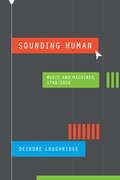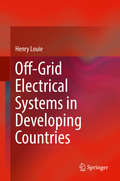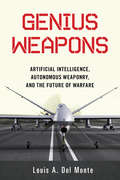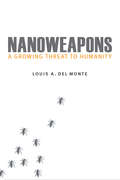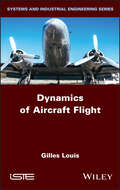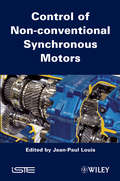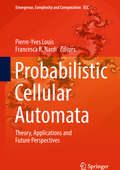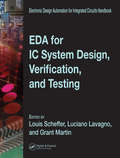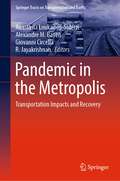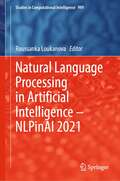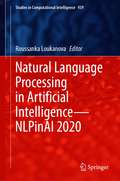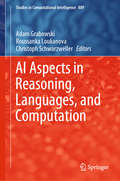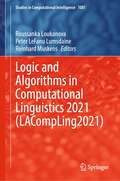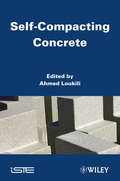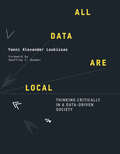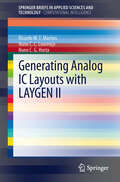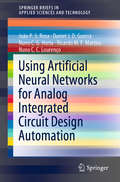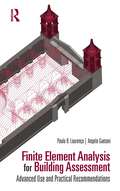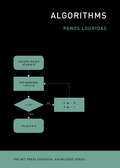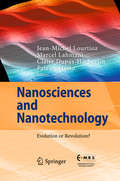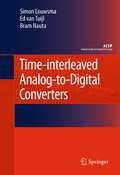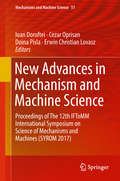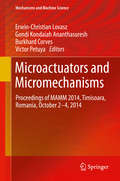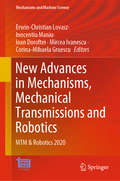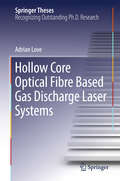- Table View
- List View
Sounding Human: Music and Machines, 1740/2020 (New Material Histories of Music)
by Deirdre LoughridgeAn expansive analysis of the relationship between human and machine in music. From the mid-eighteenth century on, there was a logic at work in musical discourse and practice: human or machine. That discourse defined a boundary of absolute difference between human and machine, with a recurrent practice of parsing “human” musicality from its “merely mechanical” simulations. In Sounding Human, Deirdre Loughridge tests and traverses these boundaries, unmaking the “human or machine” logic and seeking out others, better characterized by conjunctions such as and or with. Sounding Human enters the debate on posthumanism and human-machine relationships in music, exploring how categories of human and machine have been continually renegotiated over the centuries. Loughridge expertly traces this debate from the 1737 invention of what became the first musical android to the creation of a “sound wave instrument” by a British electronic music composer in the 1960s, and the chopped and pitched vocals produced by sampling singers’ voices in modern pop music. From music-generating computer programs to older musical instruments and music notation, Sounding Human shows how machines have always actively shaped the act of music composition. In doing so, Loughridge reveals how musical artifacts have been—or can be—used to help explain and contest what it is to be human.
Off-Grid Electrical Systems in Developing Countries
by Henry LouieThis book provides students and practicing engineers with a comprehensive guide to off-grid electrification: from microgrids and energy kiosks to solar home systems and solar lanterns. As the off-grid electrification industry grows, universities are starting and expanding courses and programs in humanitarian engineering and appropriate technology. However, there is no textbook that serves this growing market. This book fills that gap by providing a technical foundation of off-grid electrical systems, putting into context the technical aspects for developing countries, and discussing best practices by utilizing real-world data. Chapters expertly integrate the technical aspects of off-grid systems with lessons learned from industry-practitioners taking a pragmatic, data-driven perspective. A variety of off-grid systems and technologies are discussed, including solar, wind, hydro, generator sets, biomass systems, battery storage and converters. Realistic examples, case studies and practical considerations from actual systems highlight the interaction of off-grid systems with the economic, environmental, social and broader development aspects of rural electrification. Whole chapters are dedicated to the operation and control of mini-grids, load and resource estimation, and design of off-grid systems. Special topics focused on electricity access in developing countries are included, such as energy use in rural communities, technical and economic considerations of grid extension, electricity theft, metering, and best practices devoted to common problems. Each chapter is instructor friendly and contains illustrative examples and problems that reinforce key concepts. Complex, open-ended design problems throughout the book challenge the reader to think critically and deeply. The book is appropriate for use in advanced undergraduate and graduate courses related to electrical and energy engineering, humanitarian engineering, and appropriate technology.Provides a technical foundation of off-grid electrical systems;Contextualizes the technical aspects for developing countries;Captures the current and state-of-the art in this rapidly developing field.
Genius Weapons: Artificial Intelligence, Autonomous Weaponry, and the Future of Warfare
by Louis A. Del MonteA technology expert describes the ever-increasing role of artificial intelligence in weapons development, the ethical dilemmas these weapons pose, and the potential threat to humanity.Artificial intelligence is playing an ever-increasing role in military weapon systems. Going beyond the bomb-carrying drones used in the Afghan war, the Pentagon is now in a race with China and Russia to develop "lethal autonomous weapon systems" (LAWS). In this eye-opening overview, a physicist, technology expert, and former Honeywell executive examines the advantages and the potential threats to humanity resulting from the deployment of completely autonomous weapon systems. Stressing the likelihood that these weapons will be available in the coming decades, the author raises key questions about how the world will be impacted. Though using robotic systems might lessen military casualties in a conflict, one major concern is: Should we allow machines to make life-and-death decisions in battle? Other areas of concern include the following: Who would be accountable for the actions of completely autonomous weapons--the programmer, the machine itself, or the country that deploys LAWS? When warfare becomes just a matter of technology, will war become more probable, edging humanity closer to annihilation? What if AI technology reaches a "singularity level" so that our weapons are controlled by an intelligence exceeding human intelligence?Using vivid scenarios that immerse the reader in the ethical dilemmas and existential threats posed by lethal autonomous weapon systems, the book reveals that the dystopian visions of such movies as The Terminator and I, Robot may become a frightening reality in the near future. The author concludes with concrete recommendations, founded in historical precedent, to control this new arms race.
Nanoweapons: A Growing Threat to Humanity
by Louis A. Del MonteNanoweapons just might render humanity extinct in the near future—a notion that is frightening and shocking but potentially true. In Nanoweapons Louis A. Del Monte describes the most deadly generation of military weapons the world has ever encountered. With dimensions one-thousandth the diameter of a single strand of human hair, this technology threatens to eradicate humanity as it incites world governments to compete in the deadliest arms race ever. In his insightful and prescient account of this risky and radical technology, Del Monte predicts that nanoweapons will dominate the battlefield of the future and will help determine the superpowers of the twenty-first century. He traces the emergence of nanotechnology, discusses the current development of nanoweapons—such as the “mini-nuke,” which weighs five pounds and carries the power of one hundred tons of TNT—and offers concrete recommendations, founded in historical precedent, for controlling their proliferation and avoiding human annihilation. Most critically, Nanoweapons addresses the question: Will it be possible to develop, deploy, and use nanoweapons in warfare without rendering humanity extinct?
Dynamics of Aircraft Flight
by Gilles LouisPerformance calculations can be classified into three main types: lift, thrust and slope. Firstly, since the lift profile is known and unmodifiable from the time an aircraft is designed, the mass at a given speed or the speed at a given mass must be determined. Then, once the thrust of the engines and the mass are known, the slope must be calculated. Finally, once the slope is known (for example, level flight) as well as the mass, it is necessary to deduce the thrust; this is the position of the throttle control lever that ensures balance. The corresponding consumption must then be defined. Performance specifications for customer aircraft, such as manoeuvrability, fuel consumption, maintenance, safety and testability, have become ever more demanding with each generation of equipment. Major technical advances have been required: wing profiles, engines, materials to reduce mass, etc. This book presents a theoretical approach to flight mechanics that makes it possible to grasp the subject and links it with the empirical approach of manufacturers.
Control of Non-conventional Synchronous Motors (Wiley-iste Ser.)
by Jean-Paul LouisClassical synchronous motors are the most effective device to drive industrial production systems and robots with precision and rapidity. However, numerous applications require efficient controls in non-conventional situations. Firstly, this is the case with synchronous motors supplied by thyristor line-commutated inverters, or with synchronous motors with faults on one or several phases. Secondly, many drive systems use non-conventional motors such as polyphase (more than three phases) synchronous motors, synchronous motors with double excitation, permanent magnet linear synchronous motors, synchronous and switched reluctance motors, stepping motors and piezoelectric motors. This book presents efficient controls to improve the use of these non-conventional motors. Contents 1. Self-controlled Synchronous Motor: Principles of Function and Simplified Control Model, Francis Labrique and François Baudart.2. Self-controlled Synchronous Motor: Dynamic Model Including the Behavior of Damper Windings and Commutation Overlap, Ernest Matagne.3. Synchronous Machines in Degraded Mode, Damien Flieller, Ngac Ky Nguyen, Hervé Schwab and Guy Sturtzer.4. Control of the Double-star Synchronous Machine Supplied by PWM Inverters, Mohamed Fouad Benkhoris.5. Vectorial Modeling and Control of Multiphase Machines with Non-salient Poles Supplied by an Inverter, Xavier Kestelyn and Éric Semail.6. Hybrid Excitation Synchronous Machines, Nicolas Patin and Lionel Vido.7. Advanced Control of the Linear Synchronous Motor, Ghislain Remy and Pierre-Jean Barre.8. Variable Reluctance Machines: Modeling and Control, Mickael Hilairet, Thierry Lubin and Abdelmounaïm Tounzi.9. Control of the Stepping Motor, Bruno Robert and Moez Feki .10. Control of Piezoelectric Actuators, Frédéric Giraud and Betty Lemaire-Semail.
Probabilistic Cellular Automata: Theory, Applications And Future Perspectives (Emergence, Complexity And Computation Ser. #27)
by Pierre-Yves Louis Francesca R. NardiThis book explores Probabilistic Cellular Automata (PCA) from the perspectives of statistical mechanics, probability theory, computational biology and computer science. PCA are extensions of the well-known Cellular Automata models of complex systems, characterized by random updating rules. Thanks to their probabilistic component, PCA offer flexible computing tools for complex numerical constructions, and realistic simulation tools for phenomena driven by interactions among a large number of neighboring structures. PCA are currently being used in various fields, ranging from pure probability to the social sciences and including a wealth of scientific and technological applications. This situation has produced a highly diversified pool of theoreticians, developers and practitioners whose interaction is highly desirable but can be hampered by differences in jargon and focus. This book – just as the workshop on which it is based – is an attempt to overcome these difference and foster interest among newcomers and interaction between practitioners from different fields. It is not intended as a treatise, but rather as a gentle introduction to the role and relevance of PCA technology, illustrated with a number of applications in probability, statistical mechanics, computer science, the natural sciences and dynamical systems. As such, it will be of interest to students and non-specialists looking to enter the field and to explore its challenges and open issues.
EDA for IC System Design, Verification, and Testing (Electronic Design Automation for Integrated Circuits Hdbk)
by Louis Scheffer, Luciano Lavagno and Grant MartinPresenting a comprehensive overview of the design automation algorithms, tools, and methodologies used to design integrated circuits, the Electronic Design Automation for Integrated Circuits Handbook is available in two volumes. The first volume, EDA for IC System Design, Verification, and Testing, thoroughly examines system-level design, microarchitectural design, logical verification, and testing. Chapters contributed by leading experts authoritatively discuss processor modeling and design tools, using performance metrics to select microprocessor cores for IC designs, design and verification languages, digital simulation, hardware acceleration and emulation, and much more. Save on the complete set.
Pandemic in the Metropolis: Transportation Impacts and Recovery (Springer Tracts on Transportation and Traffic #20)
by Anastasia Loukaitou-Sideris Alexandre M. Bayen Giovanni Circella R. JayakrishnanThis book brings together reports of original empirical studies which explore the impacts of the COVID-19 pandemic on urban mobility and transportation and the associated policy responses. Focusing on the California region, the book draws on this local experience to formulate general lessons for other regions and metropolitan areas. The book examines how the COVID-19 pandemic has had different impacts on vulnerable populations in cities. It explores the pandemic's impacts on the transportation industry, in particular public transit, but also on other industries and economic interests that rely on transportation, such as freight trucking, retail and food industries, and the gig-economy. It investigates the effect of the viral outbreak on automobile traffic and associated air quality and traffic safety, as well as on alternative forms of work, shopping, and travel which have developed to accommodate the conditions it has forced on society. With quantitative data supported with illustrations and graphs, transportation professionals, policymakers and students can use this book to learn about policies and strategies that may instigate positive change in urban transport in the post-pandemic period.
Natural Language Processing in Artificial Intelligence — NLPinAI 2021 (Studies in Computational Intelligence #999)
by Roussanka LoukanovaThe book covers theoretical work, approaches, applications, and techniques for computational models of information, language, and reasoning. Computational and technological developments that incorporate natural language are proliferating. Adequate coverage of natural language processing in artificial intelligence encounters problems on developments of specialized computational approaches and algorithms. Many difficulties are due to ambiguities in natural language and dependency of interpretations on contexts and agents. Classical approaches proceed with relevant updates, and new developments emerge in theories of formal and natural languages, computational models of information and reasoning, and related computerized applications. Its focus is on computational processing of human language and relevant medium languages, which can be theoretically formal, or for programming and specification of computational systems. The goal is to promote intelligent natural language processing, along with models of computation, language, reasoning, and other cognitive processes.
Natural Language Processing in Artificial Intelligence—NLPinAI 2020 (Studies in Computational Intelligence #939)
by Roussanka LoukanovaThis book covers theoretical work, applications, approaches, and techniques for computational models of information and its presentation by language (artificial, human, or natural in other ways). Computational and technological developments that incorporate natural language are proliferating. Adequate coverage encounters difficult problems related to ambiguities and dependency on context and agents (humans or computational systems). The goal is to promote computational systems of intelligent natural language processing and related models of computation, language, thought, mental states, reasoning, and other cognitive processes.
AI Aspects in Reasoning, Languages, and Computation (Studies in Computational Intelligence #889)
by Roussanka Loukanova Adam Grabowski Christoph SchwarzwellerThis book builds on decades of research and provides contemporary theoretical foundations for practical applications to intelligent technologies and advances in artificial intelligence (AI). Reflecting the growing realization that computational models of human reasoning and interactions can be improved by integrating heterogeneous information resources and AI techniques, its ultimate goal is to promote integrated computational approaches to intelligent computerized systems. The book covers a range of interrelated topics, in particular, computational reasoning, language, syntax, semantics, memory, and context information. The respective chapters use and develop logically oriented methods and techniques, and the topics selected are from those areas of logic that contribute to AI and provide its mathematical foundations.The intended readership includes researchers working in the areas of traditional logical foundations, and on new approaches to intelligent computational systems.
Logic and Algorithms in Computational Linguistics 2021 (Studies in Computational Intelligence #1081)
by Roussanka Loukanova Peter LeFanu Lumsdaine Reinhard MuskensThis book assesses the place of logic, mathematics, and computer science in present day, interdisciplinary areas of computational linguistics. Computational linguistics studies natural language in its various manifestations from a computational point of view, both on the theoretical level (modeling grammar modules dealing with natural language form and meaning and the relation between these two) and on the practical level (developing applications for language and speech technology). It is a collection of chapters presenting new and future research. The book focuses mainly on logical approaches to computational processing of natural language and on the applicability of methods and techniques from the study of formal languages, programming, and other specification languages. It presents work from other approaches to linguistics, as well, especially because they inspire new work and approaches.
Self-Compacting Concrete (Wiley-iste Ser. #558)
by Ahmed LoukiliSelf-Compacting Concrete (SCC) is a relatively new building material. Nowadays, its use is progressively changing the method of concrete placement on building sites. However, the successful use of SCC requires a good understanding of the behavior of this material, which is vastly different from traditional concrete. For this purpose, a lot of research has been conducted on this area all over the world since 10 years. Intended for both practitioners and scientists, this book provides research results from the rheological behavior of fresh concrete to durability.
All Data Are Local: Thinking Critically in a Data-Driven Society
by Yanni Alexander LoukissasHow to analyze data settings rather than data sets, acknowledging the meaning-making power of the local.In our data-driven society, it is too easy to assume the transparency of data. Instead, Yanni Loukissas argues in All Data Are Local, we should approach data sets with an awareness that data are created by humans and their dutiful machines, at a time, in a place, with the instruments at hand, for audiences that are conditioned to receive them. The term data set implies something discrete, complete, and portable, but it is none of those things. Examining a series of data sources important for understanding the state of public life in the United States—Harvard's Arnold Arboretum, the Digital Public Library of America, UCLA's Television News Archive, and the real estate marketplace Zillow—Loukissas shows us how to analyze data settings rather than data sets.Loukissas sets out six principles: all data are local; data have complex attachments to place; data are collected from heterogeneous sources; data and algorithms are inextricably entangled; interfaces recontextualize data; and data are indexes to local knowledge. He then provides a set of practical guidelines to follow. To make his argument, Loukissas employs a combination of qualitative research on data cultures and exploratory data visualizations. Rebutting the “myth of digital universalism,” Loukissas reminds us of the meaning-making power of the local.
Generating Analog IC Layouts with LAYGEN II
by Nuno C. Lourenço Ricardo M. Martins Nuno C.G. HortaThis book presents an innovative methodology for the automatic generation of analog integrated circuits (ICs) layout, based on template descriptions and on evolutionary computational techniques. A design automation tool, LAYGEN II was implemented to validate the proposed approach giving special emphasis to reusability of expert design knowledge and to efficiency on retargeting operations.
Using Artificial Neural Networks for Analog Integrated Circuit Design Automation (SpringerBriefs in Applied Sciences and Technology)
by Nuno C. Lourenço Ricardo M. Martins João P. Rosa Daniel J. Guerra Nuno C. HortaThis book addresses the automatic sizing and layout of analog integrated circuits (ICs) using deep learning (DL) and artificial neural networks (ANN). It explores an innovative approach to automatic circuit sizing where ANNs learn patterns from previously optimized design solutions. In opposition to classical optimization-based sizing strategies, where computational intelligence techniques are used to iterate over the map from devices’ sizes to circuits’ performances provided by design equations or circuit simulations, ANNs are shown to be capable of solving analog IC sizing as a direct map from specifications to the devices’ sizes. Two separate ANN architectures are proposed: a Regression-only model and a Classification and Regression model. The goal of the Regression-only model is to learn design patterns from the studied circuits, using circuit’s performances as input features and devices’ sizes as target outputs. This model can size a circuit given its specifications for a single topology. The Classification and Regression model has the same capabilities of the previous model, but it can also select the most appropriate circuit topology and its respective sizing given the target specification. The proposed methodology was implemented and tested on two analog circuit topologies.
Finite Element Analysis for Building Assessment: Advanced Use and Practical Recommendations (Assessment, Repair and Strengthening for the Conservation of Structures)
by Paulo B. Lourenço Angelo GaetaniExisting structures represent a heterogeneous category in the global built environment as often characterized by the presence of archaic materials, damage and disconnections, uncommon construction techniques and subsequent interventions throughout the building history. In this scenario, the common linear elastic analysis approach adopted for new buildings is incapable of an accurate estimation of structural capacity, leading to overconservative results, invasive structural strengthening, added intervention costs, excessive interference to building users and possible losses in terms of aesthetics or heritage values. For a rational and sustainable use of the resources, this book deals with advanced numerical simulations, adopting a practical approach to introduce the fundamentals of Finite Element Method, nonlinear solution procedures and constitutive material models. Recommended material properties for masonry, timber, reinforced concrete, iron and steel are discussed according to experimental evidence, building standards and codes of practice. The examples examined throughout the book and in the conclusive chapter support the analyst’s decision-making process toward a safe and efficient use of finite element analysis. Written primarily for practicing engineers, the book is of value to students in engineering and technical architecture with solid knowledge in the field of continuum mechanics and structural design.
Algorithms: A Beginner's Guide (The MIT Press Essential Knowledge series)
by Panos LouridasIn the tradition of Real World Algorithms: A Beginner's Guide, Panos Louridas is back to introduce algorithms in an accessible manner, utilizing various examples to explain not just what algorithms are but how they work.Digital technology runs on algorithms, sets of instructions that describe how to do something efficiently. Application areas range from search engines to tournament scheduling, DNA sequencing, and machine learning. Arguing that every educated person today needs to have some understanding of algorithms and what they do, in this volume in the MIT Press Essential Knowledge series, Panos Louridas offers an introduction to algorithms that is accessible to the nonspecialist reader. Louridas explains not just what algorithms are but also how they work, offering a wide range of examples and keeping mathematics to a minimum.
Nanosciences and Nanotechnology
by Jean-Michel Lourtioz Marcel Lahmani Claire Dupas-Haeberlin Patrice HestoThis book provides information to the state of art of research in nanotechnology and nano medicine and risks of nano technology. It covers an interdisciplinary and very wide scope of the latest fundamental research status and industrial applications of nano technologies ranging from nano physics, nano chemistry to biotechnology and toxicology. It provides information to last legislation of nano usage and potential social impact too. The book contains also a reference list of major European research centers and associated universities offering licences and master of nano matter. For clarity and attractivity, the book has many illustrations and specific inserts to complete the understanding of the scientific texts.
Time-interleaved Analog-to-Digital Converters
by Simon Louwsma Ed Van Tuijl Bram NautaTime-interleaved Analog-to-Digital Converters describes the research performed on low-power time-interleaved ADCs. A detailed theoretical analysis is made of the time-interleaved Track & Hold, since it must be capable of handling signals in the GHz range with little distortion, and minimal power consumption. Timing calibration is not attractive, therefore design techniques are presented which do not require timing calibration. The design of power efficient sub-ADCs is addressed with a theoretical analysis of a successive approximation converter and a pipeline converter. It turns out that the first can consume about 10 times less power than the latter, and this conclusion is supported by literature. Time-interleaved Analog-to-Digital Converters describes the design of a high performance time-interleaved ADC, with much attention for practical design aspects, aiming at both industry and research. Measurements show best-inclass performance with a sample-rate of 1.8 GS/s, 7.9 ENOBs and a power efficiency of 1 pJ/conversion-step.
New Advances in Mechanism and Machine Science: Proceedings Of The 12th Iftomm International Symposium On Science Of Mechanisms And Machines (syrom 2017) (Mechanisms and Machine Science #57)
by Erwin Christian Lovasz Cezar Oprisan Ioan Doroftei Doina PislaThis volume presents the proceedings of the 12th IFToMM International Symposium on Science of Mechanisms and Machines (SYROM 2017), that was held in "Gheorghe Asachi” Technical University of Iasi, Romania, November 02-03, 2017. It contains applications of mechanisms in several modern technical fields such as mechatronics and robotics, biomechanics, machines and apparatus. The book presents original high-quality contributions on topics related to mechanisms within aspects of theory, design, practice and applications in engineering, including but not limited to: theoretical kinematics, computational kinematics, mechanism design, experimental mechanics, mechanics of robots, dynamics of machinery, dynamics of multi-body systems, control issues of mechanical systems, mechanisms for biomechanics, novel designs, mechanical transmissions, linkages and manipulators, micro-mechanisms, teaching methods, history of mechanism science, industrial and non-industrial applications. In connection with these fields, the book combines the theoretical results with experimental tests.
Microactuators and Micromechanisms
by Erwin-Christian Lovasz Gondi Kondaiah Ananthasuresh Burkhard Corves Victor PetuyaThis book contains applications of micromechanisms and microactuators in several very modern technical fields such as mechatronics, biomechanics, machines, micromachines, robotics and apparatuses. In connection with its topic, the work combines the theoretical results with experimental tests on micromechanisms and microactuators. The book presents the most recent research advances in Machine and Mechanisms Science. It includes the accepted reviewed papers of researchers specialized in the topics of the conference: microactuators and micro-assembly, micro sensors involving movable solids, micro-opto-mechanical devices, mechanical tools for cell and tissue studies, micromanipulation and micro-stages, micro-scale flight and swimming, micro-robotics and surgical tools, micron-scale power generation, miniature manufacturing machines, micromechatronics and micro-mechanisms, biomechanics micro and nano scales and control issues in microsystems. The presented applications of micromechanisms and microactuators in many technical fields will interest industrial companies and encourage scientifical knowledge and cooperation between academia and industry.
New Advances in Mechanisms, Mechanical Transmissions and Robotics: MTM & Robotics 2020 (Mechanisms and Machine Science #88)
by Erwin-Christian Lovasz Inocentiu Maniu Ioan Doroftei Mircea Ivanescu Corina-Mihaela GruescuThis volume gathers the proceedings of the Joint International Conference of the XIII International Conference on Mechanisms and Mechanical Transmissions (MTM) and the XXIV International Conference on Robotics (Robotics), held in Timişoara, Romania. It addresses the applications of mechanisms and transmissions in several modern technical fields such as mechatronics, biomechanics, machines, micromachines, robotics and apparatus. In doing so, it combines theoretical findings and experimental testing. The book presents peer-reviewed papers written by researchers specialized in mechanism analysis and synthesis, dynamics of mechanisms and machines, mechanical transmissions, biomechanics, precision mechanics, mechatronics, micromechanisms and microactuators, computational and experimental methods, CAD in mechanism and machine design, mechanical design of robot architecture, parallel robots, mobile robots, micro and nano robots, sensors and actuators in robotics, intelligent control systems, biomedical engineering, teleoperation, haptics, and virtual reality.
Hollow Core Optical Fibre Based Gas Discharge Laser Systems (Springer Theses)
by Adrian LoveThe research in this book represents the culmination of a drive to build the first discharge gas laser unencumbered by the effects of diffraction. This breakthrough has been achieved through careful implementation of a discharge within a hollow-core optical fibre, and by developing measurement and analysis techniques to demonstrate laser action in an experimental optical cavity. Gas lasers were amongst the earliest laser types to be demonstrated and commercialised, but it was recognised that noble gas lasers were limited by the minimum bore diameter of the laser tube, which is set by diffraction. The advent, in 2011, of hollow optical fibres with optical and physical properties suitable for gas discharge lasers opened up the opportunity to break this diffraction limit. Using a mixture of helium and xenon gas, lasing in the mid-infrared range was achieved using a 100µm core flexible hollow optical fibre which, at 1m long, is several hundred times the diffraction-limited Rayleigh length.
